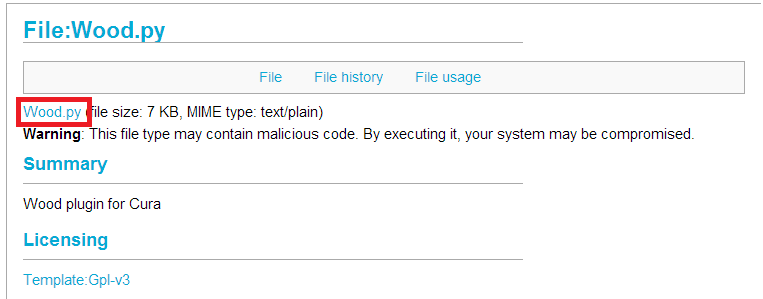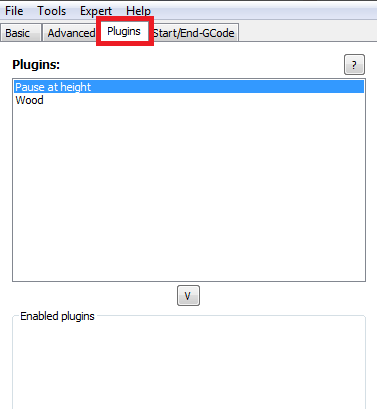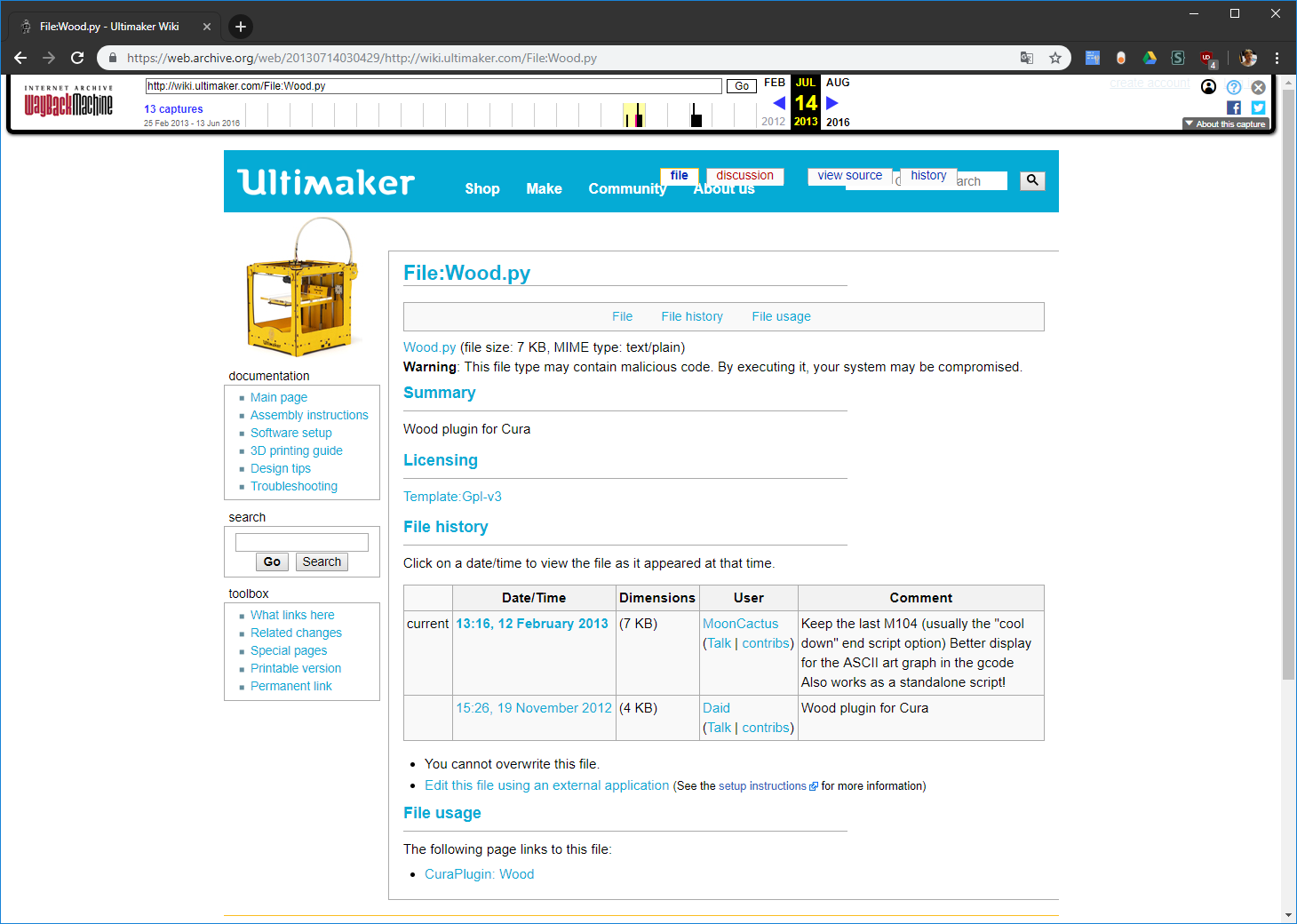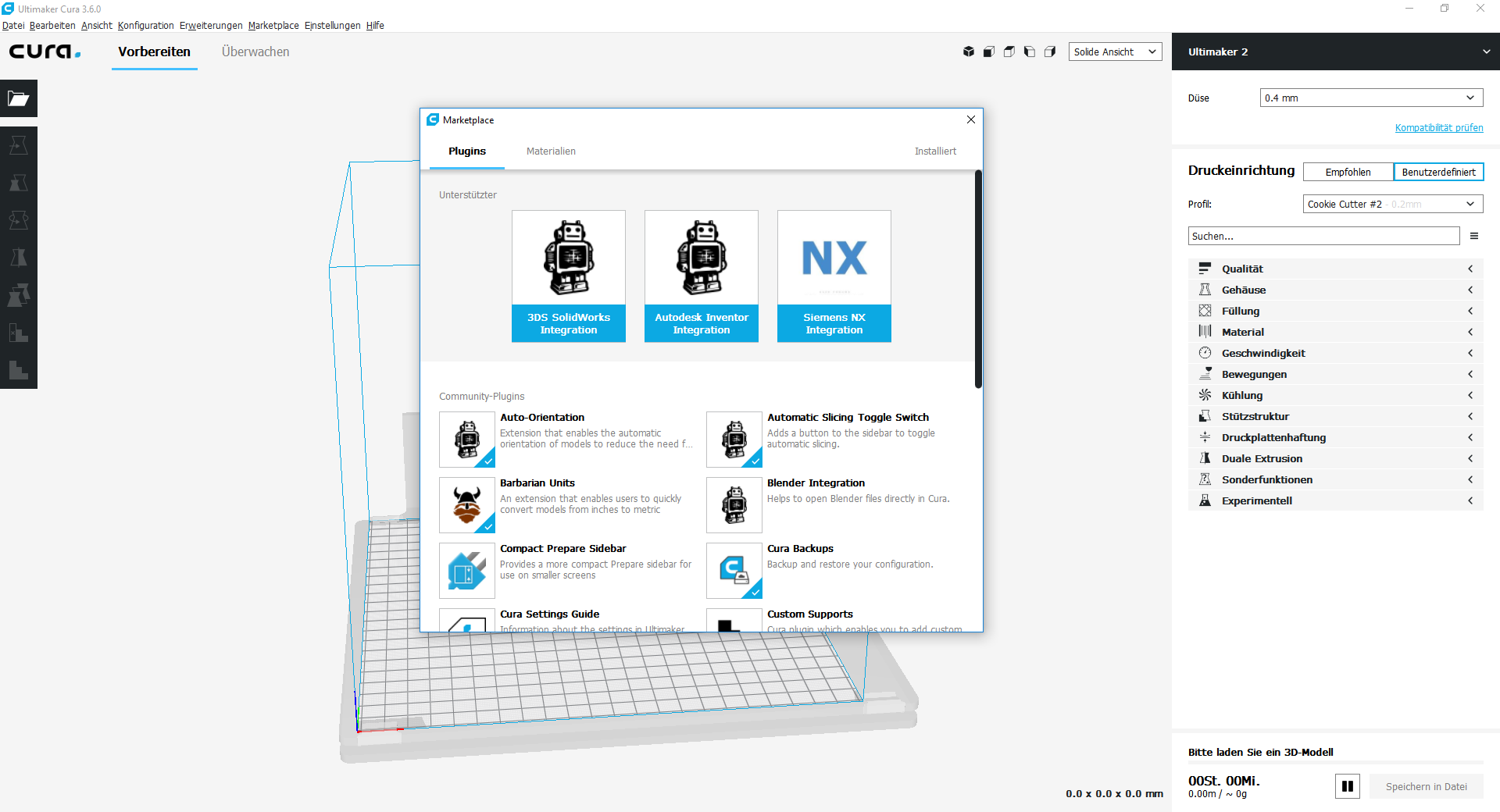Installation Wood-Plugin
Für spezielle Anwendungen gibt es Plugins, die man in Cura einbetten kann. Hier eine kurze Anleitung für das Wood-Plugin.
- Plugin von der Ultimaker-Seite herunterladen und provisorisch speichern

Rechtsklick – Link speichern unter
- Plugin-Ordner von Cura finden

Den Reiter „Plugin“ öffnen

Mit diesem Button geht der Plugin-Ordner von Cura auf
-
Vorher gespeicherte Datei in diesen Plugin-Ordner speichern
-
Cura neu starten
-
Im Reiter „Plugin“ sollte das Plugin erscheinen. Mit dem Pfeil und dem Kreuz kann es aktiv bzw. inaktiv gesetzt werden.

Achtung: Plugin soll nur aktiv sein, wenn ein spezieller Slice-Vorgang ansteht.
Update 30.12.2018
Das Ultimaker Wiki gibt es nicht mehr, es wurde durch die Rubrik Ressourcen abgelöst. Ihr findet da nebst den offiziellen Informationen zu eurem Druckermodell auch eine Vielzahl von Tipps und Tricks.

Die Seite im Wiki, welche wir 2013 für diesen Beitrag verwendet haben, ist dank dem Internet Archiv erhalten geblieben. Sogar das Plugin Wood.py, sowie die Seite CuraPlugin: Wood ist noch verfügbar. Hier der Inhalt vom 28. Mai 2013, via Wayback Machine des Internet Archivs:
CuraPlugin: Wood
Author: Jeremie Francois
Download: File:Wood.py
**Description**
Update: 2013-02-12
If you're using wood filled filaments, you can create a veneer-like finish by varying the temperature with every layer that is printed. This plugin will create this variation. Other filament may also feature such shades but the effect is less drastic than with wood.
Warning: better not leave wood in a hot nozzle for too long as it may clog it with carbon dirt in the long term. I highly recommend to purge the nozzle with PLA or ABS after you are done. This was off-topic ;)
The main settings are:
- minimal temperature
- maximal temperature
- grain size
The min/max temperatures specify the temperature range. A higher themperature gives darker bands (due to more wood being burnt). The grain size is "how wide the stripes are on average" in millimeters. A lower value generates faster changes in temperatures, while a higher value results in a wider texture.
In the beginning of the "GCode view", you will see an ASCII-art plot of the temperature variation along the layers. This way, you can check if it suits your expectations before printing your object.
Do NOT forget to disable the plugin after you are done with wood, else it may get applied to your next objects without regards to the usual and global temperature you would set.
**Special feature**
This file also works as a standalone Python script! Just run it as:
> python wood.py --min minTemp --max maxTemp --grain grainSize --file gcodeFile
or in brief mode:
> python wood.py -i minTemp -a maxTemp -g grainSize -f gcodeFile
This will "patch" your gcode file in place (it will be modified), so keep a backup if you need one. You can run the command multiple times until you are OK with the embedded temperature curve (open it in a text editor and refresh each time)
- minTemp is the minimum temperature to use (the code ensures that it is reached)
- maxTemp is the maximum temperature to use (the code ensures that it is reached)
- grainSize lets you tweak the "average thickness" of the layers
The gcodeFile is the only compulsory parameter. Default values are minTemp=190, maxTemp=240 and grainSize=3.
On windows you may want to check the FAQ here: docs.python.org/2/faq/windows.html
**Internals**
The plugin inserts M104 temperature changes each time the Z position is changed. The existing temperature settings are overridden. It also tries to protect the last values, where it is usually set to zero (cooldown).
Actually, I made it sure by tweaking the "End GCode" snippet, so that the final "M104 S0" appears after the last Z move due to homing. The plugin will not insert M104 when there is no more Z change.
You will some examples and more information on my [blog].
Die Anleitung in diesem Beitrag bezieht sich auf eine alte Version 13.04 von Cura aus dem Jahr 2013. Unsere Anleitung funktioniert immer noch mit dieser alten Version.
Der Marketplace in Cura 3.6.0
In der aktuellen Version von Cura können Plugins direkt über den eingebauten Marketplace installiert und aktualisiert werden. Nebst Plugins finden sich da seit neustem auch die Integration in CAD-Systeme und Materialprofile von namhaften Herstellern, so auch das Profil für woodFill von colorFabb, analog zu Plugin in unserem Beispiel oben.

Neu müssen alle Plugins offiziell über Ultimaker eingereicht werden, dafür erscheinen sie dann direkt im eingebauten Marketplace. Die Anleitung: Creating Packages liefert die nötigen Informationen, wie man sein eigenes Plugin einreichen kann.



Kommentare